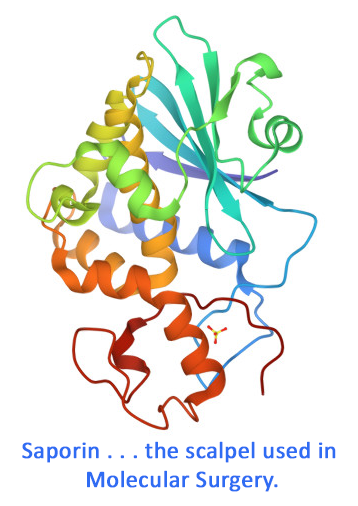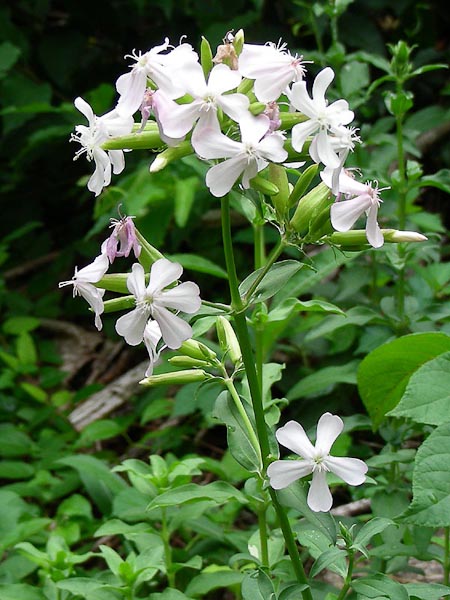Saporin is obtained from the seeds of the Soapwort plant (Saponaria officinalis), a plant that grows wildly in Britain and other parts of Europe. Saporin is a plant enzyme with N-glycosidase activity that depurinates a specific nucleotide in the ribosomal RNA 28S, thus irreversibly blocking protein synthesis. It belongs to the well-characterized family of ribosome-inactivating proteins (RIPs). There are two types of RIPs: type I (like Saporin), which are much less cytotoxic due to the lack of the B chain and type II, which are distinguished from type I RIPs by the presence of the B chain and their ability to enter cells on their own. However, type I RIPs can still be internalized by fluid-phase endocytosis. Upon internalization, the ribosomes are inactivated, resulting in cell death.
Saporin (molecular weight 30 kDa) has no known specificity. Saporin is purified from the seeds of the Soapwort plant (Saponaria officinalis). The product is routinely tested for activity by a protein synthesis inhibition assay.
Saporin serves as a control for targeted saporin immunotoxins or ligand toxins.
keywords: saporin, saponaria officinalis, plant enzyme, RIP, ribosome-inactivating protein, RIP I, internalization, cell death, targeting
Tailoring combinatorial lipid nanoparticles for intracellular delivery of nucleic acids, proteins, and drugs.
Li Y, Ye Z, Yang H, Xu Q (2022) Tailoring combinatorial lipid nanoparticles for intracellular delivery of nucleic acids, proteins, and drugs. Acta Pharm Sin B 12(6):2624-2639. doi: 10.1016/j.apsb.2022.04.013
Objective: To highlight the recent progress in combinatorial lipid nanoparticles (LNPs) with novel structures and properties for the delivery of small- and macromolecular therapeutics.
Summary: The administration of protein/LNP negatively impacted reproduction in rats, including sperm production, estrous cyclicity and testicular and ovarian morphology, without causing any significant side effects. This non-surgical approach can be developed into a safe and convenient strategy for controlling the overproduction of pet and wildlife.
Usage: Intravenous administration of saporin loaded LNPs
Related Products: Saporin (Cat. #PR-01)
Suicide nanoplasmids coding for ribosome-inactivating proteins
Mitdank H, Tröger M, Sonntag A, Shirazi NA, Woith E, Fuchs H, Kobelt D, Walther W, Weng A (2022) Suicide nanoplasmids coding for ribosome-inactivating proteins. Eur J Pharm Sci 170:106107. doi: 10.1016/j.ejps.2021.106107
Objective: To investigate the anti-proliferative activity of suicide-nanoplasmids.
Summary: In an in vivo neuroblastoma tumor model, treated mice showed a reduced tumor growth.
Usage: Design of a suicide nanoplasmid vector with saporin.
Related Products: Saporin (Cat. #PR-01)
Targeting a vulnerable septum-hippocampus cholinergic circuit in a critical time window ameliorates tau-impaired memory consolidation
Wu D, Yu N, Gao Y, Xiong R, Liu L, Lei H, Jin S, Liu J, Liu Y, Xie J, Liu E, Zhou Q, Liu Y, Li S, Wei L, Lv J, Yu H, Zeng W, Zhou Q, Xu F, Luo MH, Zhang Y, Yang Y, Wang JZ (2023) Targeting a vulnerable septum-hippocampus cholinergic circuit in a critical time window ameliorates tau-impaired memory consolidation. Mol Neurodegener 18(1):23. doi: 10.1186/s13024-023-00614-7 PMID: 37060096
Objective: There is an urgent need to study the targeting strategy for the MS-hippocampus cholinergic pathway to rescue tau-impaired memory.
Summary: Abnormal tau accumulation and cholinergic degeneration are hallmark pathologies in the brains of patients with Alzheimer’s disease (AD). However, the sensitivity of cholinergic neurons to AD-like tau accumulation and strategies to ameliorate tau-disrupted spatial memory in terms of neural circuits still remain elusive. The authors found that cholinergic neurons with an asymmetric discharge characteristic in the MS-hippocampal CA1 pathway are vulnerable to tau accumulation. Photoactivating MS-CA1 cholinergic inputs within a critical 3 h time window during memory consolidation efficiently improved tau-induced spatial memory deficits in a theta rhythm dependent manner. 192-IgG-Saporin was used to create an Alzheimer’s Disease animal model.
Related Products: 192-IgG-SAP (Cat. #IT-01)
See Also:
browse all references for this product | back to top



Reviews
There are no reviews yet.